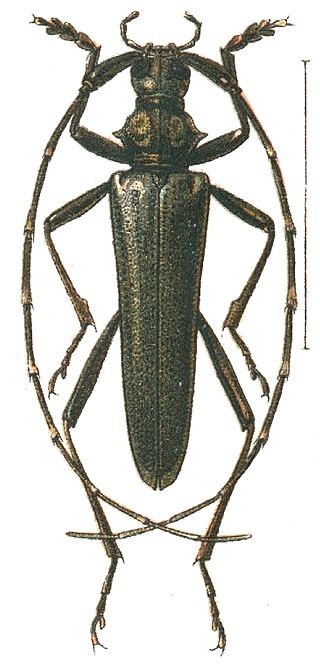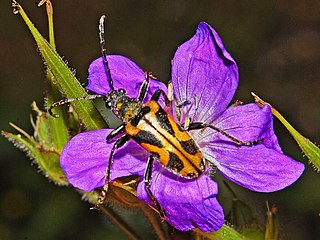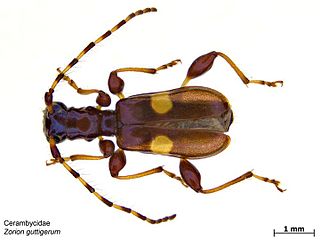
Beetles are insects that form the order Coleoptera, in the superorder Endopterygota. Their front pair of wings are hardened into wing-cases, elytra, distinguishing them from most other insects. The Coleoptera, with about 400,000 described species, is the largest of all orders, constituting almost 40% of described insects and 25% of all known animal life-forms; new species are discovered frequently, with estimates suggesting that there are between 0.9 and 2.1 million total species. Found in almost every habitat except the sea and the polar regions, they interact with their ecosystems in several ways: beetles often feed on plants and fungi, break down animal and plant debris, and eat other invertebrates. Some species are serious agricultural pests, such as the Colorado potato beetle, while others such as Coccinellidae eat aphids, scale insects, thrips, and other plant-sucking insects that damage crops.

The insects of the beetle family Chrysomelidae are commonly known as leaf beetles, and include over 37,000 species in more than 2,500 genera, making up one of the largest and most commonly encountered of all beetle families. Numerous subfamilies are recognized, but the precise taxonomy and systematics are likely to change with ongoing research.

The longhorn beetles (Cerambycidae), also known as long-horned or longicorns, are a large family of beetles, with over 35,000 species described. Most species are characterized by extremely long antennae, which are often as long as or longer than the beetle's body. In various members of the family, however, the antennae are quite short and such species can be difficult to distinguish from related beetle families such as the Chrysomelidae. The scientific name of this beetle family goes back to a figure from Greek mythology: after an argument with nymphs, the shepherd Cerambus was transformed into a large beetle with horns.

Clytus is a genus of longhorn beetles in the family Cerambycidae.

The Disteniidae are a small family of beetles in the superfamily Chrysomeloidea, traditionally treated as a group within the Cerambycidae.

Lepturinae, the lepturine beetles, is a subfamily of the longhorn beetle family (Cerambycidae), containing about 150 genera worldwide. This lineage is most diverse in the Northern Hemisphere. Until recently the subfamily Necydalinae was included within the lepturines, but this has been recently recognized as a separate subfamily. Nine tribes are usually recognized today, with a tenth, Caraphiini, created in 2016. A few genera are of uncertain placement within the subfamily.

Brachyta interrogationis is the species of the Lepturinae subfamily in long-horned beetle family. This species was described in 1758 by Carl Linnaeus in the 10th edition of Systema Naturae under the name Leptura interrogationis.

Gaurotes virginea is a species of the Lepturinae subfamily in the long-horned beetle family.

Pseudovadonia livida, the fairy-ring longhorn beetle, is a beetle species of flower longhorns belonging to the family Cerambycidae, subfamily Lepturinae.

Stenurella melanura is a flower longhorn beetle species of the family Cerambycidae, subfamily Lepturinae.

Agapanthia is a genus of flat-faced longhorn beetle belonging to the family Cerambycidae, subfamily Lamiinae.
Styloxus fulleri is a species of beetle in the family Cerambycidae. It was described by George Henry Horn in 1880.

Lepturobosca chrysocoma is a species of beetle in the family Cerambycidae. It was described as Cosmosalia chrysocoma by William Kirby in 1837. In 1998, comparison of Cosmalia chrysocoma with Lepturobosca virens by the Russian entomologist Alexander Ivanovich Miroshnikov resulted in Cosmalia and Lepturobosca grouped together under the name Lepturobosca. Common names used for this beetle include Yellow velvet beetle, Golden flower longhorn beetle and Golden-haired flower longhorn.

Mallosia, described by Étienne Mulsant in 1847, is a genus of longhorn beetles of the subfamily Lamiinae, tribe Saperdini. It is distributed in the Palearctic, from Greece to Caucasus and Iran.

Blosyropus spinosus, also known as the spiny longhorn or spiny silver-pine borer, is a rare species of longhorn beetle endemic to New Zealand. It has no specific Māori name, but the term for large longhorns of this type are howaka and kapapa.

Lepturini is a tribe of flower longhorns in the family Cerambycidae.

The lemon tree borer, also known as the whistling beetle or the singing beetle, is a longhorn beetle endemic to New Zealand. Its larvae are generalist feeders, boring into the wood of a wide variety of trees, native and introduced. When citrus orchards were first established in New Zealand, this beetle started inflicting serious damage, and so gained the name "lemon tree borer". Four species within the genus Oemona have been identified, suggesting that more species could be found. When disturbed by predators or humans, the adult beetle stridulates creating a "rasp" or "squeak" sound by rubbing its thorax and head together against an area of thin ridges. Māori would eat a liquid called "pia manuka", which was produced by manuka trees when its wood was damaged by the larvae. When Captain Cook first arrived in NZ, his naturalists, Banks and Solander, collected a lemon tree borer in their first collection between 1769 and 1771. This oldest collected specimen can be found in the British Museum. A few years after the first collection, the species would be first described by the Danish naturalist Fabricius in 1775.
Euporus is a genus of beetles belonging to the large subfamily Cerambycinae in the family of longhorn beetles (Cerambycidae).

Zorion guttigerum, commonly known as the flower long-horn beetle, is an endemic species of beetle in New Zealand. It is found on the flowers of many plant species and feeds on nectar and pollen.

Oplatocera is a genus of longhorn beetle with about ten species distributed in Asia. The genus is identified by the wide mandibles without teeth on their inner edge with the base being hairy. The antenna base has a thick joint and the third segment is longer than the fourth and the segments shorten from base to tip. The third to seventh antennal segments have spines on the outer margins in some species.


















